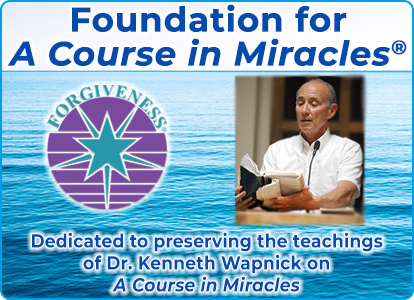
Click on an excerpt, audio or video tab to open.
Click on an excerpt, audio
or video tab to open.
Best Viewed in Landscape
Q: I am wondering about my grandmother who has Alzheimer’s Disease. What does A Course in Miracles say about this situation? She is not the same person, it just seems to be her body and not her soul. I was wondering if she was already in Heaven and her body was just left here on earth for the rest of us to learn some sort of lesson. Please help me understand this.
A: Watching someone deteriorate from this form of disease is not easy, and we hope that you are able to experience the peace deep within you and in your grandmother as you go through this. The Course’s teachings about sickness are very difficult for most people to accept and relate to because it tells us that despite all appearances, the body is never sick, anymore than a puppet is sick because the puppeteer makes the puppet move and appear a certain way. The clear teaching in the Course is that the body does only what the mind tells it to do, and, more deeply, that the body is not an entity separate from the mind. Other systems teach that the soul leaves the body and goes to Heaven, but that is not what A Course in Miracles teaches. Sickness is made by the ego to reinforce our belief that we are bodies and not spirit; so all forms of sickness (there is no hierarchy among them) are a defense against the truth of Who we truly are as Christ (W-pI.136).
We can never know the specifics of someone else’s Atonement path (nor our own most of the time), but it is possible that your grandmother (as a decision-making mind) chose the condition of Alzheimer’s to help others learn that they are not bodies and that this world is not our home. We don’t know this. The condition of the body is not a clear indicator of what is going on in the mind since the identical bodily condition can reflect either a wrong-minded or a right-minded choice. So to apply the teachings of the Course in this type of a trying situation you first would simply respect her choice, and then try to see the situation as a classroom, focusing only on which teacher you are choosing to guide you through it: either the ego or Jesus. The ego would have you see your grandmother’s deterioration as a terrible, unfortunate tragedy for which someone is to blame. Jesus would help you deal with your feelings and judgments and see beyond them to the light and love that define both you and your grandmother, as well as everyone else: “It [the miracle] merely looks on devastation, and reminds the mind that what it sees is false … it paves the way for the return of timelessness and love’s awakening, for fear must slip away under the gentle remedy it brings” (W-pII.13.1:3,6).
Excerpted from Q&A
AUDIO
Press play arrow to listen.
The ego’s understanding of giving is that when I give you something, I no longer have it. If I give you something, you have more of it and I have less of it. Giving, to the ego, is always quantitative. Now, this is so whether we are talking about material things, or we are talking about psychological things or thoughts. One of the key aspects of projection is that by my giving you my guilt I am free of it, and you have it. We always believe that when we give a thought away, then someone else has it and we do not have it.
The miracle corrects that and teaches us that what we give we also receive, since we are all one. Since I am really not giving anything that is out here, because there is nothing out here, it is all in my mind. Giving, then, is really a reinforcement. If I give you my guilt by projecting it onto you and attacking you, what I am really doing is reinforcing my own guilt. If I give you love, then what I am doing is reinforcing the fact that there is a Presence of Love Who is within me, and that Presence, the Holy Spirit, is the One Who is really giving the love. That is why what we give away we really receive. Giving and receiving are the same. That is one of the key principles found in the material. Several workbook lessons have that as their basic idea (e.g., Lessons 108, 126), and certainly the text discusses it over and over again.
Miracles, then, become an exchange. I allow the Holy Spirit to extend His Love through me, which not only reinforces who you are, as a child of love, but it also reinforces who I am, healing both of us.
That idea is a reversal of how the world thinks or the ego thinks, and that is what the statement means. It reverses the physical laws because the world teaches, again, that what we give away we have less of, so that the more miracles we choose, and the more we can allow ourselves to be the instruments of the miracle, the more we receive the benefits of the miracle. The more that we love, heal, and forgive, the more loved, healed, and forgiven we become. The St. Francis Prayer is a lovely expression of that principle.
Excerpted from The Fifty Miracle Principles

